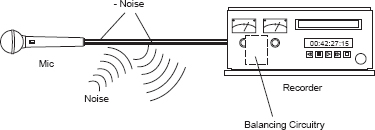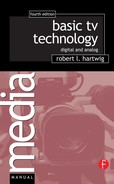Big differences — home and professional audio equipment.
Professional and Consumer Audio
Impedance
Very early in this book we discussed the concept of impedance. In the world of video, life was simple because there was one impedance for everything. It is very different in the world of audio. Consumer video is high impedance (10,000 Ω (ohms)). High-impedance equipment is less expensive to manufacture, has poorer sound quality, and can only be sent down short cables. Professional equipment is low impedance (600 Ω or less). Low-impedance equipment has better sound quality, can be sent down longer cables, and is more expensive. There are converters that will change high impedance to low impedance and low to high, but the good ones are fairly expensive.
Balanced and Unbalanced Audio
Consumer audio is also unbalanced. Unbalanced audio uses only two wires to carry the message and does not resist induced noise. (Please see the section on fields (induction) and noise early in the book.) Balanced audio systems use three wires to carry the message and resist induced noise. This resistance to noise and, therefore, cleaner signal is the big advantage of balanced audio.
The system works as follows. Of the three wires that carry the message, one of them is the ground and the other two carry the exact same signal at the same time; the two signals are “in phase.” Noise is likely to hit these two wires at slightly different times and not be quite the same in both wires. The noise will be “out of phase.” The equipment receiving the signal lets things that are in phase pass through but will filter out things that are out of phase. Thus, much of the noise can be filtered out. For the system to work, both links of the system must be balanced. Balanced and unbalanced components can be hooked together, but you will lose the advantages of balanced audio. There are pieces of equipment that will allow you to plug in an unbalanced source and make it balanced from that point on.
Consumer equipment, then, is always high-impedance unbalanced, and professional equipment is low-impedance balanced. There is equipment that will convert high-impedance unbalanced to low-impedance balanced and low-impedance balanced to high-impedance unbalanced. This will allow you to mix consumer and professional equipment and get the best sound possible. The use of this equipment, however, is usually limited to the studio. The equipment is bulky and needs to be plugged into a power source, which makes it difficult to use it in the field.
Unbalanced audio lets induced noise pass through.

Balanced audio filters out induced noise that is out of phase.

